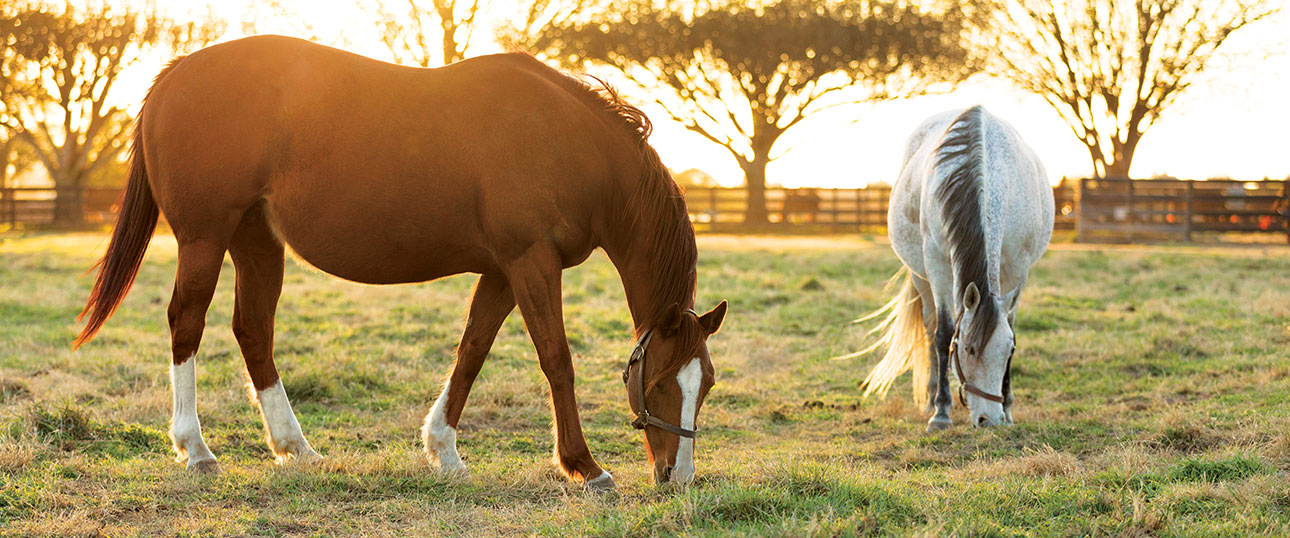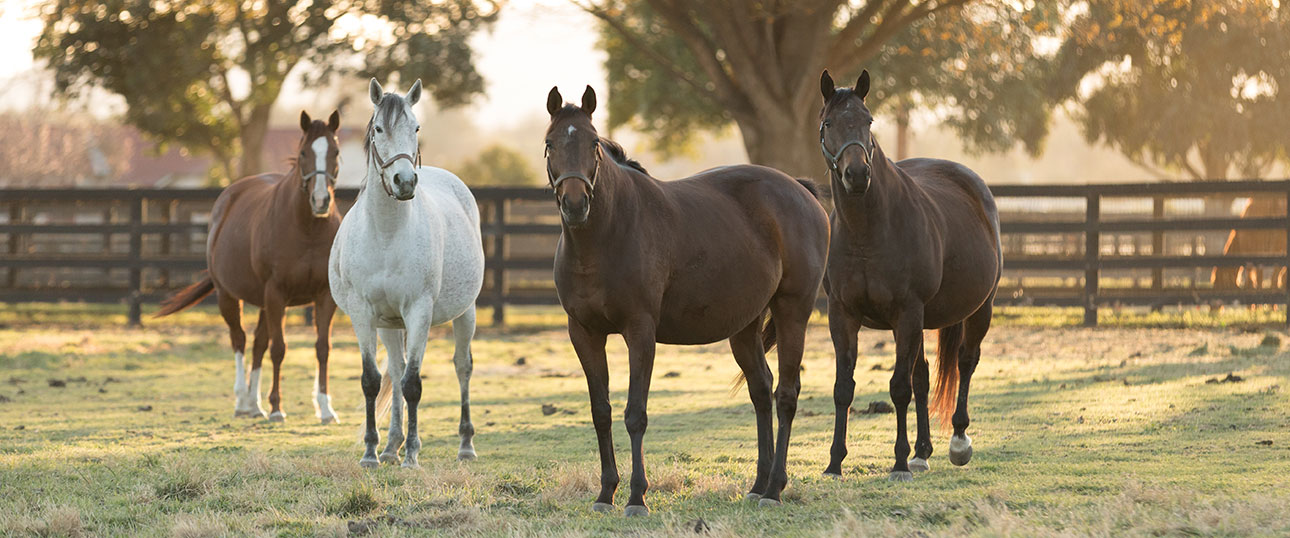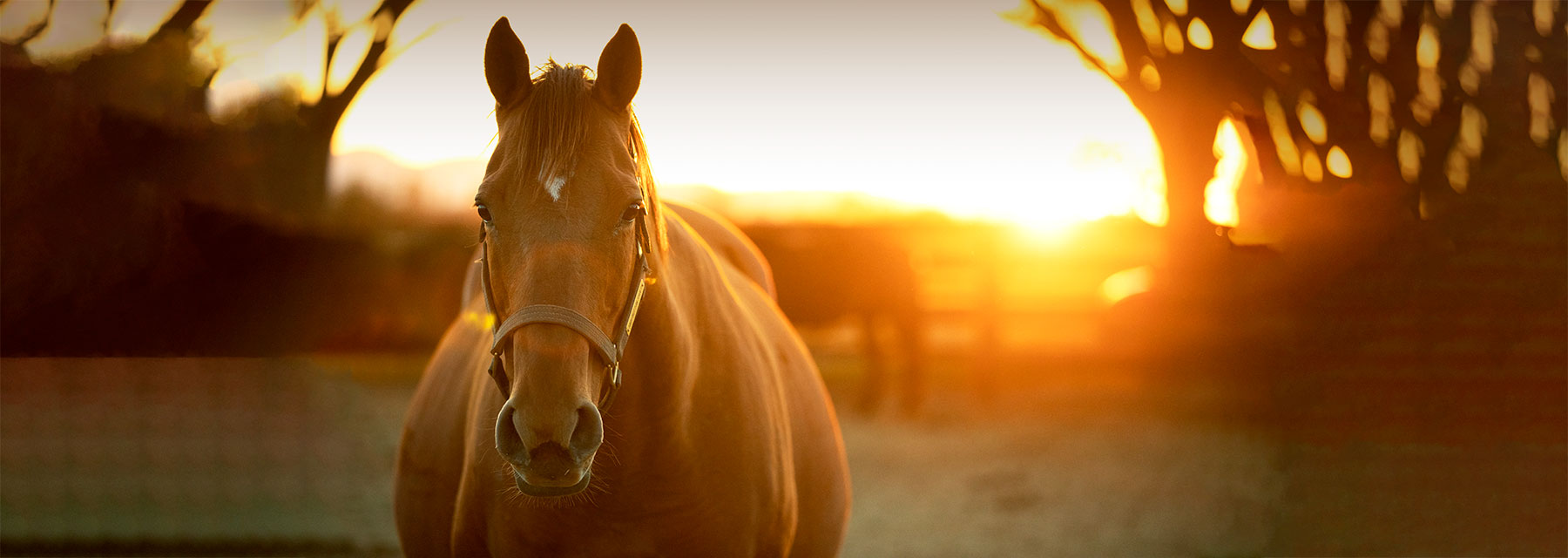Ensuring That The Broodmare is Nourished for Success Prior to Breeding, During Gestation and After Foaling
So much more than simply a vehicle for delivering her foal, the broodmare is the ultimate cultivator of equine life. Her body prepares for then creates, nurtures, grows and ultimately introduces the next generation of great athletes into the world. Formerly the broodmare was viewed as simply a carrier for the foal within, but veterinarians have worked to evolve our thinking when it comes to the care and support that should be given to broodmares at every stage of gestation and after foaling. “In women, there is a huge focus on prenatal care to ensure a healthy pregnancy for both the mother and her growing baby,” says Emily Smith, MS, Equine Clinical Nutritionist with Platinum Performance ®. “Similarly, a healthy mare is more likely to conceive, remain healthy through gestation and produce a well-developed foal. Just like in human pregnancy, the mare is the sole source of nourishment for her foal. When we feed the broodmare, we are feeding the foal,” says Smith adamantly.
Viewing the mare as the invaluable part of the breeding process that she is makes way for a next-level approach, including keen preparation, engaged management and a program that ebbs and flows with the mare’s needs to help support her long-term health and that of her foal. “I can’t overemphasize the importance of looking at the whole horse instead of just seeing her as a vehicle for the ovaries and uterus,” says Charlie Scoggin, DVM, MS, DACT, a boarded theriogenologist with Rood & Riddle Equine Hospital in Lexington, Kentucky. Dr. Scoggin is and has always considered himself a veterinarian first and a theriogenologist second, concerned above all else with the overall health and performance of the mares under his care. To him, these mares are equally as valuable as their competing counterparts. Only when their health and soundness has been confirmed do their responsibilities as a broodmare come into play. “To have a healthy horse is paramount. That gives you a much higher likelihood of having a successful pregnancy and a healthy foal,” confirms Dr. Scoggin. This approach includes evaluating a mare’s body condition, subsequent metabolic status, soundness and hoof quality, among other things. A mare with advanced arthritis, other soundness concerns, Equine Metabolic Syndrome (EMS), gut dysbiosis or ulcers, for instance, could have her ability to conceive, carry or deliver put into question.
“The last trimester is when the foal starts growing rapidly, with nearly 80 percent of total growth happening at that time. Dietary alterations will be needed to support both the mare and developing foal who will actually double in size during this short period.”
— Emily Smith, MS, Equine Clinical Nutritionist with Platinum Performance®
The Role of Body Condition
It may sound simple but maintaining a proper body condition can be an invaluable part of not only successfully breeding a mare but also in maintaining a healthy pregnancy and beyond. We hear it often in human medicine that women can encounter fertility challenges when they are under or significantly overweight. It turns out, weight and metabolic status have more to do with equine fertility than was previously thought, impacting everything from oocyte quality to the likelihood of a mare conceiving and the development and health of the foal. “It is often advocated to keep mares in ideal to slightly fleshier body conditions,” says Smith, referring to a body condition score (BCS) of five to six, which equates to the ribs being covered without the presence of excess fat. “This is ideal throughout pregnancy, with the understanding that the last few months of gestation requires elevated energy, protein and mineral levels to support rapid foal growth. This stage, of course, is then immediately followed by the immense nutrient drain of lactation, with the mare’s milk being the primary food source for the foal for several months after birth,” adds Smith. A mare’s gestation period is approximately 11 months long, with her nutrient requirements actually resembling a typical maintenance state until the last four to five months prior to foaling. “The last trimester is when the foal starts growing rapidly, with nearly 80 percent of total growth happening at that time. Dietary alterations will be needed to support both the mare and developing foal who will actually double in size during this short period,” explains Smith.
While maintaining an ideal body condition is imperative during gestation, it is also critical prior to breeding, to help ensure successful conception from the outset. Both underweight and overweight mares are an ever-present challenge encountered by veterinarians, often complicating their jobs. “We unfortunately see mares that come in either underweight or obese,” says Ryan Ferris, DVM, DACT, of Summit Equine in Gervais, Oregon. “We really don’t see many mares in an ideal body condition.” It’s a frustration for Dr. Ferris and his colleagues, with their goals always set on achieving successful outcomes as quickly as possible. Body condition challenges can contribute to an elongated process, with mares often taking upwards of three to four cycles to become pregnant. While there are steps he and his team take to address the body condition and overall health of the mares in their care, to Dr. Ferris, the key to the equation is in preparation. “Say the breeding season starts February 1st. I’d like nutritional considerations to have been made as early as September or October, and at least by November or December,” he says of his ideal scenario. “When the mares arrive to us a few hundred pounds overweight in February, it can be too late to properly address it.”
While excess weight may sound simple enough to address and perhaps relatively harmless, the reality can be significantly more dire for both the mare’s overall health and her chances of successfully becoming pregnant. “We’re often dealing with overweight mares, aged mares or both,” says Dr. Ferris. “Due to that excess weight, metabolic disease is a very real concern, as is the frequent fact that these mares are often being fed like the performance animals they used to be when their jobs and activity levels have now changed dramatically. They’ve shifted into a broodmare career, and they don’t exercise as hard, they’re often not put on the walker as frequently, and they aren’t necessarily ridden every day. Even with these lifestyle changes and changes to their metabolic rate, they’re sometimes still being fed as though they’re training and competing. Before breeding and during the first five to seven months of gestation, they need to be fed in relation with the workload they’re under just like any horse,” says Dr. Ferris.
While it’s logical to assume that being overweight is less than ideal for a mare, or any horse for that matter, why is it really such a concern? “It has been concretely shown in human medicine that body condition scores of mothers during pregnancy can influence the metabolic status of their children,” says Dr. Ferris, inferring that the same link may very well be the case in the horse. While equine research in this area is a bit behind our human counterparts, suspicions are leaning toward a similar link. “In the horse, we’re starting to show that, yes, foals born from obese mares will have different metabolic rates than those born from mares in lighter to normal weight ranges. It’ll be interesting to see the continued results as these studies mature and the foals being tracked mature in age. Will we see that some of the metabolic conditions that we face in horses were actually predetermined in some way by their mothers? Time will tell,” says Dr. Ferris of the ongoing research.

“Once the mare reaches her fifth month of gestation, nutrient requirements for energy and protein begin to increase. Then, from gestational month seven until the time of foaling, the requirements for many macro and trace minerals increase.”
— Meri Stratton-Phelps, DVM, MPVM, DACVIM, (LAIM), DACVN, Equine Clinical Nutritionist for Platinum Performance®
Importance of Nutrition During Gestation
While proper nutrition is imperative as a crucial step in preparation for breeding, it becomes even more imperative during gestation. “During early pregnancy, it is important that broodmares are not overfed and do not gain excessive weight,” points out Meri Stratton-Phelps, DVM, MPVM, DACVIM, (LAIM), DACVN, Equine Clinical Nutritionist with Platinum Performance®. “Once the mare reaches her fifth month of gestation, nutrient requirements for energy and protein begin to increase. Then from gestational month seven until the time of foaling, the requirements for many macro and trace minerals increase,” says Dr. Stratton-Phelps.
A key component of a proper diet during gestation comes from forage. “As the mare’s pregnancy advances and also when she is lactating, it is important to ensure that she is being fed a good quality and highly-digestible hay, or that she has access to good-quality grass pasture. Forage (as grass or hay) should comprise at least 70 percent of the ration by volume,” says Dr. Stratton-Phelps. Always an advocate for quality forage, Emily Smith agrees. “Adding some alfalfa to grass hays at 10 to 25 percent of the total hay volume is helpful to provide a good source of calories, quality protein source and calcium as well as other necessary minerals. If it’s possible to test your hay, it may be worthwhile to know more precisely what your hay is providing and what might need to be augmented through feeds or supplementation. Hays can vary quite widely in mineral content, and it can be handy to know what you’re dealing with, particularly during the last trimester,” says Smith. It’s a point that Dr. Ferris stands behind. “In today’s world, our forages travel a lot, sometimes even across the country. We’re here in the Northwest, and there’s a large hay company that farms here. When I was an intern in Ocala, Florida, I realized this company had a distribution center there, and they were selling hay from the Northwest in the Southeast. It’s important to know where your hay comes from, test it and realize that you can’t count on a typical nutrient profile of a certain region when, in reality, your hay could be trucked in from several states away.” Although forage is crucial and supports both nutrient intake and gut motility, Dr. Stratton-Phelps cautions equine caregivers to be aware of certain toxicities. “Fescue hay and fescue pasture can be toxic to mares in their last trimester of pregnancy if it is infected with the endophytic fungus Acremonium coenophiliam. This fungus produces a compound called ergovaline that causes adverse effects in both the mare and in her developing foal. An abnormally-long increase in gestation, the development of a thickened placenta, premature placental separation, dystocia, abnormally-long placental retention following delivery of the foal and agalactia may develop in the mare following ingestion of endophyte-infected fescue. Abortions and stillbirths, or birth of a dysmature foal, are also adverse consequences that may develop if the mare consumes endophyte-infected fescue,” warns Dr. Stratton-Phelps.
In addition to a quality forage being fed, both Smith and Dr. Stratton-Phelps recommend that mares be put on a comprehensive vitamin and trace mineral supplement to complement their forage intake. “In many cases I recommend Platinum Performance® Equine and if needed, Platinum Balance® for its added gastrointestinal support," says Smith. “They each contain omega-3 fatty acids, vitamin A, vitamin E and selenium, among other vitamins and minerals, which is an ideal combination, especially if the mare doesn’t have access to pasture and is on a hay-only diet.” Smith also advocates that plain, white salt be made available to satisfy sodium and chloride needs, with iodized table salt being an option to support both salt and essential iodine intake. While a quality-forage diet paired with a comprehensive wellness supplement that is shown to be safe for pregnant and lactating mares covers the bases for most mares, there are some that require additional calories to maintain a healthy body condition both during gestation and after foaling. “I’ll often use a concentrate or an oil like Platinum’s Healthy Weight, which is a cold-pressed flax oil infused with natural vitamin E. I like that healthy source of calories versus a more pro-inflammatory choice like corn oil,” says Smith of her strategy. While supplementation can be a vital tool to help support the needs of both the mare and developing foal, it’s important that caregivers investigate the ingredients in their mares’ commercial feeds and supplements, choosing reputable companies with defined quality testing procedures to help ensure that the ingredients being fed to a pregnant or lactating mare are, in fact, safe.
As gestation progresses toward the last three to four months and the foal is developing rapidly, some adjustments to a mare’s diet become necessary. “Feeding the late pregnant mare does not have to be complicated,” points out Smith. “In fact, continuing a simple forage-based diet is the best way to ensure health. During this time and into lactation, the mare will require more calories, and it is not uncommon for the mare to gain a pound per day in the last trimester.” Specifically, protein requirements increase, with typical commercial feeds delivering 10 to 12 percent crude protein and feeds geared toward broodmares offering 14 to 16 percent. “In a lot of cases, performance or athletic feeds can easily double as broodmare feeds,” suggests Smith. She’s quick to remind, however, that the quality of the amino acid balance and levels of lysine in a feed are more important than simply the quantity of crude protein it offers.
In addition to protein requirements, Smith also points out some nuances regarding calcium. “As is the case for several nutrients, the foal will take the calcium it needs for growth and can leave the mare potentially deficient if enough isn’t provided in the diet,” she says. “Adding a concentrate feed for more ‘concentrated’ calories and nutrients can be beneficial in some cases, or a ration balancer can be considered to ensure that the mare’s protein, vitamin and mineral (particularly copper, zinc and various macro minerals like calcium, phosphorus and magnesium) needs are being met. This is where a little bit of the ‘art’ of feeding comes in,” says Smith. “Feeding your individual broodmare is this awesome connection of art high-fiving science. Use the minimum amount of concentrate feed needed to maintain her weight and don’t get stuck thinking, ‘I have to feed my mare (a certain amount) of feed.’ It really depends on the mare. If she starts getting too heavy on a feed, switch her to a ration balancer, which provides all of the nutrients without the calories. Also, choose a quality supplement that includes omega-3 fatty acids, antioxidants, vitamins and trace minerals.” Dr. Stratton-Phelps is also an advocate for realizing the benefits of vitamin E in late-stage gestation. “Vitamin E supplementation in mares during late pregnancy can increase the concentration of immunoglobulins in the mare’s colostrum, which can have a positive effect on foal health by providing higher levels of passive immunity following colostrum ingestion by the neonatal foal,” she says.
While “eating for two” isn’t necessarily the goal with pregnant mares, the mare is in fact providing nutrition for two. “Understanding the vital role the mare’s nutritional status has during gestation is so important. It is, of course, important for the foal but also critical for the mare as she gives birth and moves into early lactation — the most nutritionally-draining stage of life,” adds Smith.
“It’s important to know where your hay comes from, test it and realize that you can’t count on a typical nutrient profile of a certain region when, in reality, your hay could be trucked in from several states away.”
— Ryan Ferris, DVM, DACT, Summit Equine in Gervais, Oregon
Supporting the Lactating Mare
Just as in new human mothers, a mare’s nutrient requirements and caloric needs elevate significantly as she enters lactation. She is the sole nutrient provider for her foal, and the equine body has a miraculous way of sustaining the mare while single-handedly nurturing and growing a new life, all beginning with colostrum intake immediately after foaling. “Before parturition and during the late gestational period, the mammary gland concentrates immunoglobulins from the mare’s serum into the mammary gland to produce the immunoglobulin-rich colostrum. These immunoglobulins from the mare (IgG, IgA, IgM) provide the newborn foal with essential immune support that helps maintain foal health,” explains Dr. Stratton-Phelps of this fascinating process. “Following the production of colostrum, the mare produces milk that contains a variety of nutrients including fat, protein, lactose, macro and trace minerals. Body reserves of certain nutrients (protein, lipid, minerals) and nutrients from the mare’s ration (lactose from glucose absorbed from the small intestine) provide the necessary components for the milk,” adds Dr. Stratton-Phelps. While IgG, IgA and IgM are crucial, Dr. Scoggin points out that the mare’s milk is a virtual magic potion for many reasons. “The milk has so many other goodies in there that shouldn't be overlooked, like growth factors, lots of sugars, fats and protein. A mare that is on a good nutritional plan at the time of foaling is much more likely to have good-quality colostrum and good concentrations of immunoglobulins, as well as all those other goodies that are present,” explains Dr. Scoggin.
While mares have the incredible ability to produce nutrient-rich milk to feed their foals and facilitate proper growth and immune development, veterinarians in the field like Drs. Scoggin and Ferris, see the impact that the lactation phase can have on a mare. “People breathe a sigh of relief once the foal is born healthy, stands and nurses, but they sometimes forget about the mare for a little bit,” observes Dr. Scoggin. “It's amazing how much a foal can pull from a mare in a very short period of time, and we have to be very cognizant of that, taking proactive steps to ensure that she’s maintaining her weight and staying healthy.” Weight loss in lactating mares can be a frequent challenge, with their caloric needs high and the challenge of providing them healthy calories to meet the demands of their body. “I use Healthy Weight oil to provide these mares with additional healthy calories, and I choose it because of its omega-3 fatty acids and vitamin E,” says Dr. Ferris. Like so many veterinarians, Dr. Ferris prefers a proactive approach to maintaining the health of lactating mares under his care. When it comes down to it, simple is perhaps best. “The simple use of a weight tape or a scale can help us stay ahead of these mares. Measuring their weight every two weeks allows us to look for trends and make dietary adjustments.” Maintaining the weight of the lactating mare is important for the health of the foal, her own long-term health and also directly influences her ability to quickly and efficiently become bred back. “Keeping her on a good nutritional plane with a consistent weight means that we often have a much easier time breeding her back,” confirms Dr. Scoggin.

“A mare that is on a good nutritional plan at the time of foaling is much more likely to have good-quality colostrum and good concentrations of immunoglobulins, as well as all those other goodies that are present.”
— Charlie Scoggin, DVM, MS, DACT, Boarded Theriogenologist with Rood & Riddle Equine Hospital in Lexington, Kentucky
An Evolving View of the Mare
As the role of the mare has gained increased appreciation, she has transitioned from a vehicle for the foal to an integral part of delivering equine life. She brings us our champions in the ring, superstars on the track and she’s the lifeblood of the ranch. Realizing the importance of nutrition to the mare is an ever-evolving aspect of veterinary medicine and impacts her overall health, ability to produce quality oocytes, conceive, carry and deliver a healthy foal. “Nutrition plays an extremely important role,” says Dr. Scoggin definitively. “When we realized omega 3 fatty acids, specifically docosahexaenoic acid (DHA), could help with fluid retention, we thought that was pretty neat. Now we're finding that some nutrients can potentially affect oocyte quality and metabolism. When you can provide nutrition to a horse that benefits them internally while helping them look great externally, that's an awesome feeling as a veterinarian,” he says. In agreement, Dr. Ferris adds, “We probably don’t spend enough time focusing on nutrition,” he says in earnest. “We’ve evolved in our practice to the point where we see these underweight mares come in, for instance, and they go right on Platinum Performance® Equine and Healthy Weight. We’re getting the weight on them, we’re introducing those omega-3 fatty acids and antioxidants, and we’re getting them on this program that will be on our side throughout the process.”
With an elevated appreciation for the broodmare, her nutritional needs and the benefits that a well-orchestrated program can have, veterinarians are having a greater impact on successfully breeding mares, nurturing them through gestation and celebrating the arrival of thriving foals. Today’s broodmares are being seen as vital, relevant and a critical piece of the breeding equation. She’s indeed a vehicle but think sports car, not passenger van.

Charlie Scoggin, DVM, MS, DACT
Boarded Theriogenologist with Rood & Riddle Equine Hospital in Lexington, Kentucky

Ryan Ferris, DVM, DACT
Summit Equine in Gervais, Oregon

Meri Stratton-Phelps, DVM, MPVM, DACVIM, (LAIM), DACVN
Equine Clinical Nutritionist with Platinum Performance®

Emily Smith, MS
Equine Clinical Nutritionist with Platinum Performance®

by Jessie Bengoa,
Platinum Performance®
